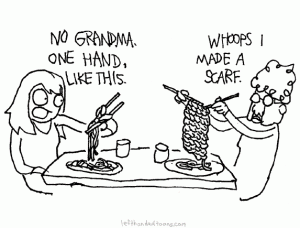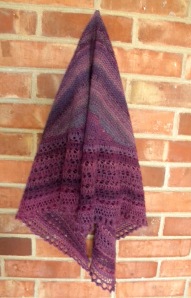
My mom in her natural habitat, surrounded by texture
There was a span of about three years when my mom used to say, “I come from a long line of chiefs,” a quote from the movie, Whale Rider. I don’t really know why she said this all the time but I assume it was just one of those things that got stuck in her head and wouldn’t remove itself from the surface of her brain. The point is that I think of her saying this whenever I think of the women in my family who have proven their crafting prowess through the generations. I come from a long line of crafters and that is almost as important as coming from a long line of chiefs. The women in my family have passed on their crafts to the next generation for as long as that new group would listen.
My great-grandmother, Monelle Huckaba, was a prolific and multi-faceted craftswoman who, when she had an idea for something to sew, would, “throw some newspaper down on the floor and trace exactly what she wanted and come up with a working pattern to make her idea from,” as reported by my mom. She embroidered, sewed, hand quilted, and cross-stitched well into her not so great years of life.
My grandmother, LaVerne Huckaba, had three girls, my mom and her two sisters, all extremely close in age that she had to dress for cheap. She made a lot of their clothes and a lot of those clothes matched. From a spectrum of pastel Easter dresses to totally rad 70’s ponchos, my grandma slaved over the sewing machine in order to master the art of dressing three opinionated girls.
Mom is a tactile person. She spent a lot of her childhood in the depths of her grandmother’s and mother’s fabric stashes and that influence took her through college where she studied Textiles and Design. She taught me how to shop and appreciate clothing and the best way to do these things is to reach out and touch whatever thing you might be walking by. As a picky teen I’d grab items off the racks and coo over how cute they were and my mom would reach out and swish it between her fingers, “Yeah, but it’s scratchy you don’t want to wear that.” The best and probably worst parts about knowing how to make your own clothes is that you become excessively picky about their look and texture.

Amazing aesthetic, terrible texture
Texture is transformative. The most heinous piece of clothing is still salvageable as long as it feels great on the skin. Texture controls a lot of our behavior whether we realize it or not. For example, babies love the silky tag on their blankets, children love the fuzzy fur of their stuffed animals, adults gravitate towards plush furniture or smooth leather. Texture makes something more than its function. The most inane object becomes sensually interesting once you discover its texture beneath the pads of ridged fingertips.
My first memorable experience with texture came when I was about five years old. My mom sewed a lot when I was young and I usually found myself around her as she hunched under the light of her trusty sewing machine and maneuvered the seams of quilts and dresses. I must have been bothering her while she was trying to work because she passed me a booklet of silk swatches in every color my mind could have imagined and told me to play with them.
That little book of a hundred colors kept me entertained for hours while my mom worked beside me. I remember laying the small rectangles out on the floor playing with the color combinations all while swishing a couple of silky pieces together between my fingers. The slick fabric sliding across itself was soothing and the colors were mesmerizing. Mom handed me a needle and thread so I could practice sewing the pieces together.
I found some of these pieces many years later while I was looking through my fabric boxes and was embarrassed by the inch long stitches all around the little pieces. A set of rectangles, one light blue and the other navy, were sewn together with crooked stitches and stuffed with polyfill to make a pincushion. I threw those pieces away in disgust at the lack of ability they showed but now I really wish I had kept them to remember that first experience by. I have yet to find a fabric that felt the way those little rectangles did and doubt that I ever will.
Mom taught me how to crochet when I was eight. We sat together in our ratty brown, gold, and green armchair with her feet propped on the matching stool, mine barely passing the crevasse between the chair and the stool. She demonstrated the looping motion of grabbing the yarn with the hook and it slid through the motions so quickly, so easily that I had no idea there was even a possibility of someone being incapable of performing the motion. She handed me the hook and yarn, wove the yarn around my fingers in just the right way so I could attempt the motion.
My wrists and fingers couldn’t perfect the synchronized motions of the rolling and tugging the hook needed to make a stitch. I let the blue aluminum hook fall to my lap in defeat. Mom left me, the chair, and the hook to our misery. After hiding the hook and yarn from my sight and spending some time in anger at my lack of skill, we tried again a few weeks later and the stitches came easily. Crafts are gained through muscle memory. If you try it once, it is easier to pick up the next time around. Creating that muscle memory makes your body hunger for more, making the repetition and furthering of creativity a necessity.

Recent crochet swatches
From knitting to quilting to embroidery to weaving, as I grew I tried it all. Some of it stuck. Some of it didn’t. What did stick was a love for the knowledge of these crafts, as well as the love for the tools these crafts necessitated. My shelves are filled with how-to books accumulated from years of Christmas gifts and inherited from familial generations who either gave up their skills for store bought items or couldn’t hold a needle between their arthritic fingers anymore. I gained tools the same way and am left with more knitting needles than I could ever have projects for and crochet hooks from the circumference of a sewing needle to a hefty man’s thumb.
Once I began college, I found myself gravitating towards textile crafts again for two reasons: I had a lot of extra time freshman year because I’m not so great at meeting people and my roommate was interested in the modest stash of yarn I had brought along with me to school. I busted that yarn out and started crocheting again. The rhythm of the stitches returned to me in a rush and I was hooked.
I threw myself into yarn and learned more about crochet and knitting in the three months of the first semester than I did about whatever my classes were focused on. I channeled all the distress I felt about being away from home and my high school sweetheart into yarn things in an attempt to stay positive. For the most part it worked out pretty well. I gained some skills and filled the time that I would have spent being lethargic and moody.
I’ve continued to foster my textile obsession at every chance I get. In my art history courses I’ve studied Indian saris and ancient Chinese silken burial shrouds. In my English courses, I’ve found ways to make my creative project about needlework. I am continually hungry for more information on textiles and am pretty damn grateful that my institution has afforded me so many opportunities to incorporate my interests into my degree in some unconventional ways.
Besides my intense curiosity about the history of crafting and collection of skills I keep coming back to textiles because the act of creating is grounding and pure. These crafts are ancient, with spinning being nearly as old as humanity itself and knitting and crochet being a bit younger but still as pivotal to our clothing histories. Being a part of this greater narrative of creativity is rewarding and fulfilling. It is so easy now to be totally disconnected from the world while being intensely connected to an artificial existence. Craft has kept me on Earth, the real Earth, and has made me more conscious of my decisions on consumption.
Crafting keeps me close with the women in my family who have passed down these skills to each other. The passing of skills bond the teacher and pupil in a way that connects them for life because they now have something interesting and ever-changing to discuss and gush about whenever they are together.
 Though I never really got to meet my great-grandmother, the master seamstress, I feel connected to her in a different way. I use her embroidery needles and snoop through her quilting books to gain inspiration. I am connected to her, my grandma, my mom, and sister through these skills. I am even connected in some small way to all other individuals who hold these skills.
Though I never really got to meet my great-grandmother, the master seamstress, I feel connected to her in a different way. I use her embroidery needles and snoop through her quilting books to gain inspiration. I am connected to her, my grandma, my mom, and sister through these skills. I am even connected in some small way to all other individuals who hold these skills.
I hope to perpetuate and heighten the prevalence of craft in modern life because I think it is so important to happiness to be doing something tangibly productive with our hands. That tangible item can foster relationships, make you happy, and even keep your head warm, what more could you ask for?
 Through these last couple of months of summer I have been prepping for the coming winter by both making garments to be worn in the event of a polar vortex sequel and building a stockpile of supplies to keep me entertained.
Through these last couple of months of summer I have been prepping for the coming winter by both making garments to be worn in the event of a polar vortex sequel and building a stockpile of supplies to keep me entertained. the garment itself is one I made up as I went along, my first wearable personal design of something other than an accessory. I love its simplicity because it lets the yarn take center stage and as a souvenir piece it personifies my trip to Ireland. I cannot wait to don it over a flannel button up this winter and have already picked out the outfit I will wear with it on the first really cold day of the year.
the garment itself is one I made up as I went along, my first wearable personal design of something other than an accessory. I love its simplicity because it lets the yarn take center stage and as a souvenir piece it personifies my trip to Ireland. I cannot wait to don it over a flannel button up this winter and have already picked out the outfit I will wear with it on the first really cold day of the year. texture. I’m using Berrocco Ultra Alpaca so the resulting piece will be beyond just warm. This is a really simple pattern and the broken rib texture is a test of my patience at this point but with four inches of the body left to go I think I can make it to the end of the piece. Plus, I know the work and slight tedium of one by one rib stitch rows over about 180 stitches will be worth it once it is blocked, dried, and tried on.
texture. I’m using Berrocco Ultra Alpaca so the resulting piece will be beyond just warm. This is a really simple pattern and the broken rib texture is a test of my patience at this point but with four inches of the body left to go I think I can make it to the end of the piece. Plus, I know the work and slight tedium of one by one rib stitch rows over about 180 stitches will be worth it once it is blocked, dried, and tried on.





























